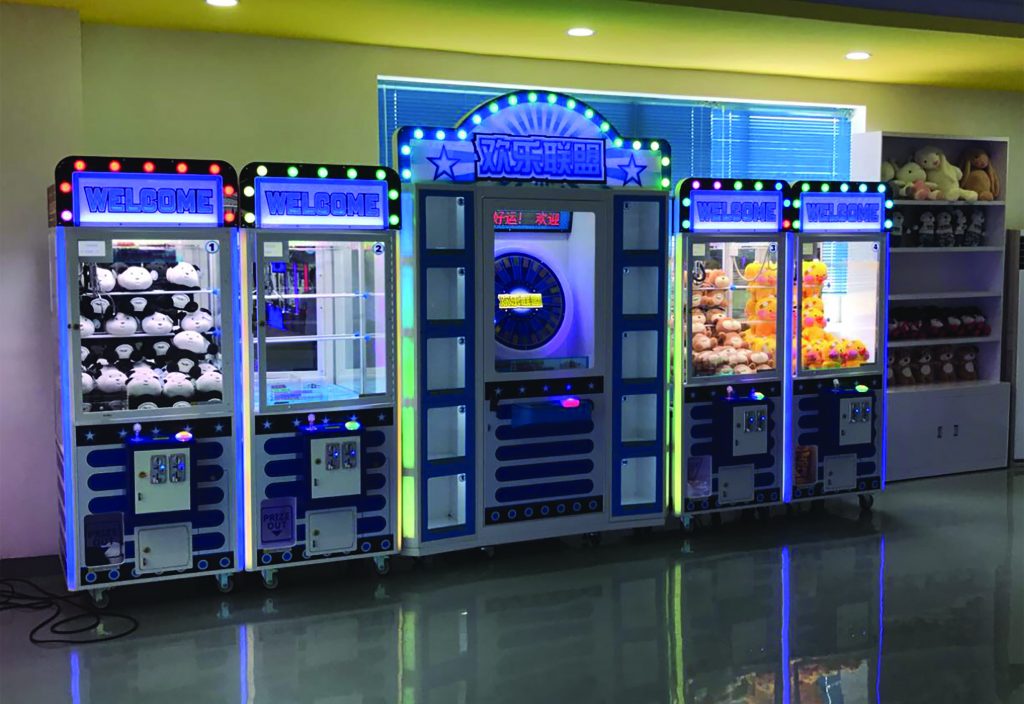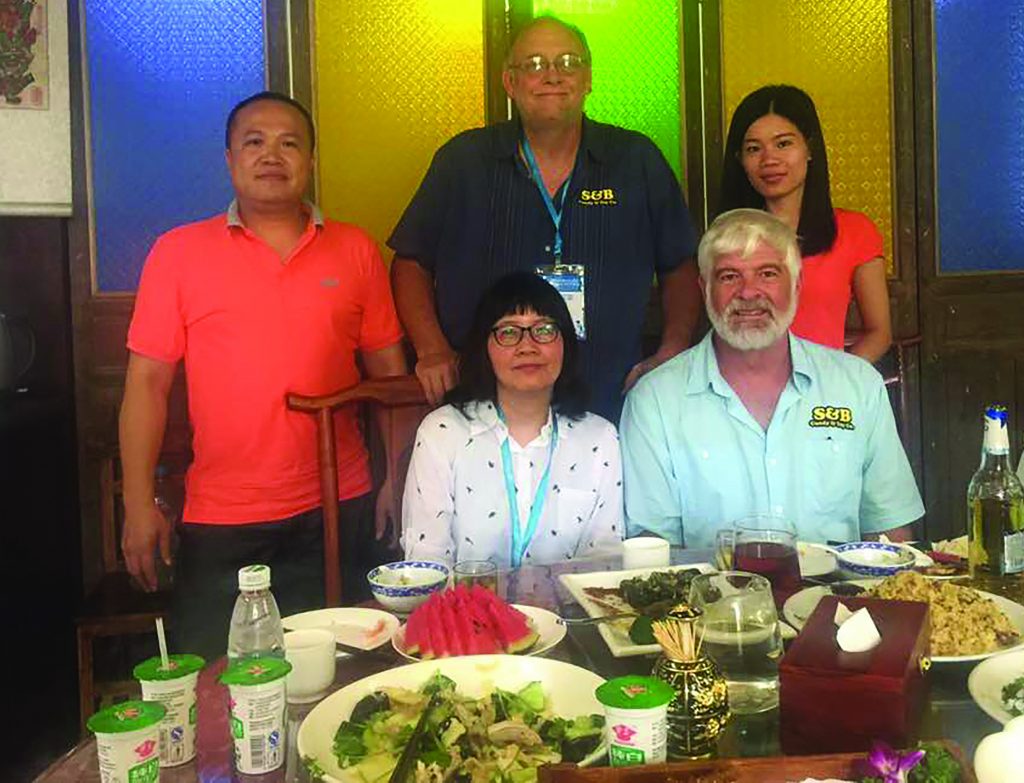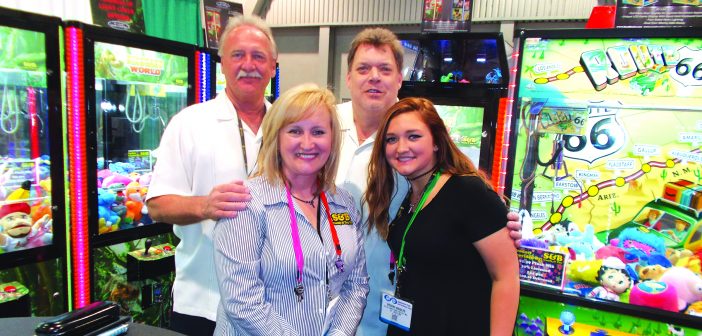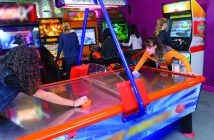S&B Candy & Toy Celebrates 25 Years
Longtime Crane Maker Highlights Bowling Center Roots & Future Focus
The cranes of the ’90s are alive today, but their successors have evolved into nearly unrecognizable marvels thanks to advances in technology and the nonstop innovation of companies like S&B Candy and Toy and its machine manufacturing business, the St. Louis Game Co.
S&B, which in 1993 began placing quaint, winner-every-time cranes in bowling centers throughout the St. Louis area, has since progressed into a global powerhouse of crane games, candy and redemption product. They haven’t lost sight of their roots, a fact apparent in speaking with company founder Brian Riggles, who started the company with Steve Tini.
“We still have 90 percent of our original employees, and that’s something everyone here is proud of,” said Riggles. “I was 26 years old when I started the company with a simple route of Snack Attack candy cranes that made ungodly amounts of money. I had seen these winner-every-time games for the first time at a video store down in Florida, and thought, dang that’s neat. I found a number in the machine, called, visited the factory and bought the six machines they had along the wall.”
Riggles says he and S&B were one of the firsts to operate winner-every-time cranes, and the early days of the company were lucrative, though not without hiccups. On one of their first collections, they came to a crane that was completely empty of product. Thinking they’d have a great haul in the cashbox, they opened it up to find eight bucks, and quickly realized that instead of ticking down from one credit to zero, the machine had been giving 99 credits to every player after a win.
“That wasn’t all either,” Riggles ruminated. “These were metal machines, you could walk up to them and smack them with your fist and they’d give you a free credit. These crazy little bugs made us tear our hair out at the start, but they set the groundwork, the foundation of our company today.”
Though today S&B has a full route with an array of locations in which to test their new equipment, Riggles and his team still have a fond place in their hearts for the bowling centers that gave them a chance early on. Those candy cranes have grown into a global company with 11 partner factories (two in Taiwan and nine in China), multiple in-house divisions and a host of products. In the beginning, the company was used to bringing in a shipping container once every six months. Last year, they brought in around 35.
“Our purchasing power and our tech have radically changed. We’re developing our own machines now, but bowling centers gave us a start, Riggles said. “We’ve come such a long way since then, with three new machines in development right now, one slated for each upcoming IAAPA show in the next three years.”
Riggles believes this longtime focus on harnessing forward momentum and innovation is one of the reasons many of his employees have stayed along for the ride, a sentiment shared by Marty Luepker. (Riggles says aside from his wife, Luepker is the first employee he hired at the company). Luepker has been behind some of the most innovative new offerings from the company, along with Riggles, who has yet another new concept ready to unveil at the Bowl Expo.
S&B has developed a new system specifically for bowling centers, which allows players to record themselves. As cameras have become ubiquitous and cheap, the company saw a way to capitalize on a variety of markets. From teens looking to upload fun videos of their bowling night, to dedicated league players wanting to analyze every micromovement in their step, swing and toss, the new system is nearly a necessity in this digital-first day and age.
“These kinds of things will keep people coming back to bowl…this is what it is all about now. We’re moving into an increasingly tech-savvy world, and you have all these TVs playing Law and Order while people bowl. Why not do something more engaging with them?” Riggles asks. “Trust me, it’ll spread quickly.”
He insists that though the idea is outside the box, especially for a company like S&B, it will make for a better investment for a bowling center than more cupholders or another set of balls. By giving players an interactive experience and putting them into the game, you’ll create a more engaging atmosphere and happier customers. It’s an idea that comes directly from the company’s long roots, and a testament to the experience and knowledge of the S&B team.
A camera system for bowling centers is far from the company’s only innovation of late. Its cranes have gone from quaint, colorless little games to massive, linkable, LED-infused, unmissable attractions. Though the gameplay is essentially the same as it was in ’93, the machine’s look and serviceability have revolutionized.
The company says it is one of the only crane companies, alongside Elaut USA, that can produce cranes with LED fronts. The company notes that these new cranes have become a mainstay at industry events and in FECs and other locations nationwide. (“Elaut and S&B are working towards a settlement of their patent infringement lawsuit. Upon finalization of the settlement, S&B will receive a license to use Elaut’s patented multicolor LED technology,” wrote Elaut USA CEO Glenn Kramer in an email to S&B.)
“You can see these new cranes from the highway, they’re impossible to miss,” Riggles said. “And impossible to keep from playing! Even on a small scale, you can have a little game room with glass windows, and a kid will be sitting there eating pizza unable to stop staring as the entire room changes colors alongside the crane.”

Prototypes of new S&B cranes expected to be exhibited this fall at the IAAPA 2018 Expo.
On top of all these innovations, one of the biggest changes they allow for, according to Riggles, is a justifiable reason to spend one dollar per play.
“It’s difficult to get away from that 50 cents when you’re operating a beat up old machine,” Riggles emphasizes. “But if you put in something that looks as nice as these do, people will pay a dollar without hesitating.”
These new cranes started with a boom that came after the 2008 economic downturn. According to Riggles, a lot of old equipment was left out on the street for a long time as operators held off on buying. As the economy recovered, there was a pent up demand for new product and S&B was there to help fill the void.
That’s not to say they’ve solely put their energy toward developing futuristic-looking machines; Riggles insists that the company’s classic Route 66 machine is –– and always will be –– its flagship product. The recognizable machine now comes in three sizes and though it keeps its nostalgic look, the machine is entirely programmable with a small keyboard. They even took the owner of one of the factories they work with in China for a ride in a muscle car along the historic road, to give him a taste of what the machine represents.
The company’s breadth of experience and knowledge is weaponized in their product department, which has customers around the world seeking expert advice on what to buy, when to buy it and when a trend has played its course. Many operators nationwide got caught up in a fidget spinner craze last year, a fad that Luepker says lasted a solid eight weeks before dying out completely. The difference between making money off that fad and losing it was knowing when to fill your games with them and when to let your inventory run out, and that insider knowledge came straight from S&B for many.
“The plush and prize business is massive, but not all of it works for a crane. 25 years of experience means we’re sourcing “craneable” merchandise, not trying to be a retail outlet,” said Riggles. “For an operator, that’s a big deal, especially with auto-percentaging going away, product needs to be a lot more consistent. If the claw strength can’t change, product needs to have a consistent weight, size and shape.”
That insider knowledge can only be acquired through time, and yet again, a few mistakes. Luepker tells the story of once selling a pirate mix to customers that included little gold coins amidst other loot. Those coins, however, happened to be the size of a quarter. You can assume what happened next.
Their 25 years in business has given them this depth of experience, and along with that, a depth of relationships across the amusement industry. They’ve been dealing with some manufacturers for so long, many of them know S&B will happily take a good deal on large quantities of product and pass those savings on to operators.
“With cranes, you can’t go from 50 cents to 54 cents, like any other store could. We’re locked into our price points, and so our customers need to have fairly priced product,” Luepker said.
Beyond their relationships with manufacturers, factories, operators and licensing professionals, the company has drastically changed its stance on the manufacturer/distributor relationship. For a long time, the company sold its crane games direct to operators and locations. Since then, Riggles says, they’ve matured.

Dinner party –– Meeting up with their Chinese factory reps are Ron Blue, Yvonne Chen (sourcing and quality control expert based in Hong Kong) and Marty Luepker.
“We have something that everyone wants, and we know now to make sure we follow the channels that make this business work,” Riggles said. “The major focus for us is product, especially with winner-every-time cranes, every time someone plays we sold something.”
The company now works directly with Player One Amusement Group, utilizing their ace-in-the-hole Jim Roe, a distribution pro who’s worked in the network for the past 30 years. Roe works alongside Riggles and the rest at S&B to ensure that P1AG and operators nationwide get what they need, when they need it.
“When I joined with Brian, he wasn’t really working with distributors,” Roe said. “I came on and knew a lot of the folks at Player One, knew they were good, trustworthy people I’d worked with in the past. Slowly, but surely, we’re working with them nationwide, moving from east to west. We started with Player One, our main distributor, but have added Greater America, Game Exchange of Colorado and others to our roster as well.”
The company’s middle-America HQ lends itself to a vast distribution network, and according to the toppers, gives them a strategic advantage over competition on either coast. They can ship all their product and games to 75 percent of the U.S. within three days.
When it comes down to it, however, Riggles says what gives them the biggest advantage is their history, and the multitudes of relationships S&B has fostered through the years. It’s a mentality that is more than apparent in speaking with any S&B employee, and a mentality that goes deeper than the next sale.
“Coming from a bigger business to this, it reaffirms my love of the family business. Especially the small family business,” said Roe, who joined the S&B team a little over two years ago. “It’s kind of like coming back to my roots. I get to leave a great impression with people. S&B is what a lot of people out there need, but they’re just not aware of it yet. Brian and everyone else here is doing it at the right pace. I’ve seen too many people come into this industry and think they can conquer the world. He’s hitting it just right.”
We’re sure Roe isn’t the only one who’d think that, and surely isn’t the only one excited to see what comes next from the burgeoning company. Until then, look for their cranes, product, prizes, plush and panache at a pizza place, bowling center, FEC, laundromat, bar or nearly any other location you can think to put a crane in. You may not have to look far!




